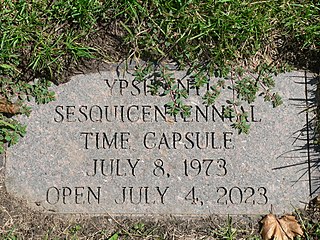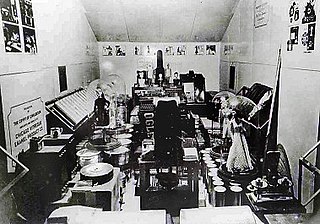
Memex is a hypothetical electromechanical device for interacting with microform documents and described in Vannevar Bush's 1945 article "As We May Think". Bush envisioned the memex as a device in which individuals would compress and store all of their books, records, and communications, "mechanized so that it may be consulted with exceeding speed and flexibility". The individual was supposed to use the memex as an automatic personal filing system, making the memex "an enlarged intimate supplement to his memory". The name memex is a portmanteau of memory and expansion.
Natural language processing (NLP) is an interdisciplinary subfield of computer science and information retrieval. It is primarily concerned with giving computers the ability to support and manipulate human language. It involves processing natural language datasets, such as text corpora or speech corpora, using either rule-based or probabilistic machine learning approaches. The goal is a computer capable of "understanding" the contents of documents, including the contextual nuances of the language within them. To this end, natural language processing often borrows ideas from theoretical linguistics. The technology can then accurately extract information and insights contained in the documents as well as categorize and organize the documents themselves.

Writing is the act of creating a persistent representation of human language. A writing system uses a set of symbols and rules to encode aspects of spoken language, such as its lexicon and syntax. However, written language may take on characteristics distinct from those of any spoken language.

A document is a written, drawn, presented, or memorialized representation of thought, often the manifestation of non-fictional, as well as fictional, content. The word originates from the Latin Documentum, which denotes a "teaching" or "lesson": the verb doceō denotes "to teach". In the past, the word was usually used to denote written proof useful as evidence of a truth or fact. In the Computer Age, "document" usually denotes a primarily textual computer file, including its structure and format, e.g. fonts, colors, and images. Contemporarily, "document" is not defined by its transmission medium, e.g., paper, given the existence of electronic documents. "Documentation" is distinct because it has more denotations than "document". Documents are also distinguished from "realia", which are three-dimensional objects that would otherwise satisfy the definition of "document" because they memorialize or represent thought; documents are considered more as two-dimensional representations. While documents can have large varieties of customization, all documents can be shared freely and have the right to do so, creativity can be represented by documents, also. History, events, examples, opinions, etc. all can be expressed in documents.

The Long Now Foundation, established in 1996, is an American non-profit organization based in San Francisco that seeks to start and promote a long-term cultural institution. It aims to provide a counterpoint to what it views as today's "faster/cheaper" mindset and to promote "slower/better" thinking. The Long Now Foundation hopes to "creatively foster responsibility" in the framework of the next 10,000 years. In a manner somewhat similar to the Holocene calendar, the foundation uses 5-digit dates to address the Year 10,000 problem. The organization's logo is X, a capital X with an overline, a representation of 10,000 in Roman numerals.

In the Ancient Near East, clay tablets were used as a writing medium, especially for writing in cuneiform, throughout the Bronze Age and well into the Iron Age.

A time capsule is a historic cache of goods or information, usually intended as a deliberate method of communication with future people, and to help future archaeologists, anthropologists, or historians. The preservation of holy relics dates back for millennia, but the practice of preparing and preserving a collection of everyday artifacts and messages to the future appears to be a more recent practice. Time capsules are sometimes created and buried during celebrations such as a world's fair, a cornerstone laying for a building, or at other ceremonies.
KEO is the name of a proposed space time capsule which was to have been launched in 2003 carrying messages from the citizens of present Earth to humanity 50,000 years from now, when it would re-enter Earth's atmosphere. Its name represents the three most frequently used sounds common to the most widely spoken languages today,, , and. Everyone was invited to contribute to the time capsule, and the organizers encouraged everybody to gather messages from children, senior citizens, and the illiterate so that every culture and demographic on Earth was represented. Moreover, the organizers were committed to not filtering the messages, stating "all the messages received, without undergoing any censorship, will be embarked aboard KEO." The launch has been delayed several times due to major geopolitical shakeups, including 9/11 and the restructuring of the ESA. As of 1 January 2021, no launch date has been confirmed.

Hallstatt is a small town in the district of Gmunden, in the Austrian state of Upper Austria. Situated between the southwestern shore of Hallstätter See and the steep slopes of the Dachstein massif, the town lies in the Salzkammergut region, on the national road linking Salzburg and Graz.

The Hallstatt culture was the predominant Western and Central European archaeological culture of the Late Bronze Age from the 12th to 8th centuries BC and Early Iron Age Europe from the 8th to 6th centuries BC, developing out of the Urnfield culture of the 12th century BC and followed in much of its area by the La Tène culture. It is commonly associated with Proto-Celtic speaking populations.

The Salzkammergut is a resort area in Austria, stretching from the city of Salzburg eastwards along the Alpine Foreland and the Northern Limestone Alps to the peaks of the Dachstein Mountains. The main river of the region is the Traun, a right tributary of the Danube.

The Crypt of Civilization is an impenetrable, airtight, room-sized time capsule, built between 1937 and 1940, at Oglethorpe University in Brookhaven, Georgia. The 2,000-cubic-foot (57 m3) repository is meant not to be opened before 8113 AD. It contains numerous artifacts and sound recordings that illustrate civilization and human development to the 20th century. Classic literature and religious texts were also deposited, as well as items showing the extent of scientific progress to 1939.
A knowledge ark is a collection of knowledge preserved in such a way that future generations would have access to said knowledge if all other copies of it were lost.

The Church of Spiritual Technology (CST) is a California 501(c)(3) non-profit corporation, incorporated in 1982, which owns all the copyrights of the estate of L. Ron Hubbard and licenses their use. CST does business as L. Ron Hubbard Library. The Church of Spiritual Technology points to Hubbard as the “focal point,” with the structure designed to realize what Scientologists understand to be his vision. The stated purpose of the archive in CST, according to the church is “so that future generations will have available to them all of L. Ron Hubbard’s technology in its exact and original form, no matter what happens to the society.”
Web archiving is the process of collecting portions of the World Wide Web to ensure the information is preserved in an archive for future researchers, historians, and the public. Web archivists typically employ web crawlers for automated capture due to the massive size and amount of information on the Web. The largest web archiving organization based on a bulk crawling approach is the Wayback Machine, which strives to maintain an archive of the entire Web.

The Westinghouse Time Capsules are two time capsules prepared by the Westinghouse Electric & Manufacturing Company. One was made in 1939 and the other in 1965. They are filled with contemporary articles used in the twentieth century way of life in the United States. The items are intended for people of the 7th millennium to receive for historical significance.

"As We May Think" is a 1945 essay by Vannevar Bush which has been described as visionary and influential, anticipating many aspects of information society. It was first published in The Atlantic in July 1945 and republished in an abridged version in September 1945—before and after the atomic bombings of Hiroshima and Nagasaki. Bush expresses his concern for the direction of scientific efforts toward destruction, rather than understanding, and explicates a desire for a sort of collective memory machine with his concept of the memex that would make knowledge more accessible, believing that it would help fix these problems. Through this machine, Bush hoped to transform an information explosion into a knowledge explosion.
Expertise finding is the use of tools for finding and assessing individual expertise. In the recruitment industry, expertise finding is the problem of searching for employable candidates with certain required skills set. In other words, it is the challenge of linking humans to expertise areas, and as such is a sub-problem of expertise retrieval.
Karina Grömer is an Austrian archaeologist known for her contribution to the study of archaeological textiles. She is the head of the Department of Prehistory at the Natural History Museum Vienna in Austria.
























